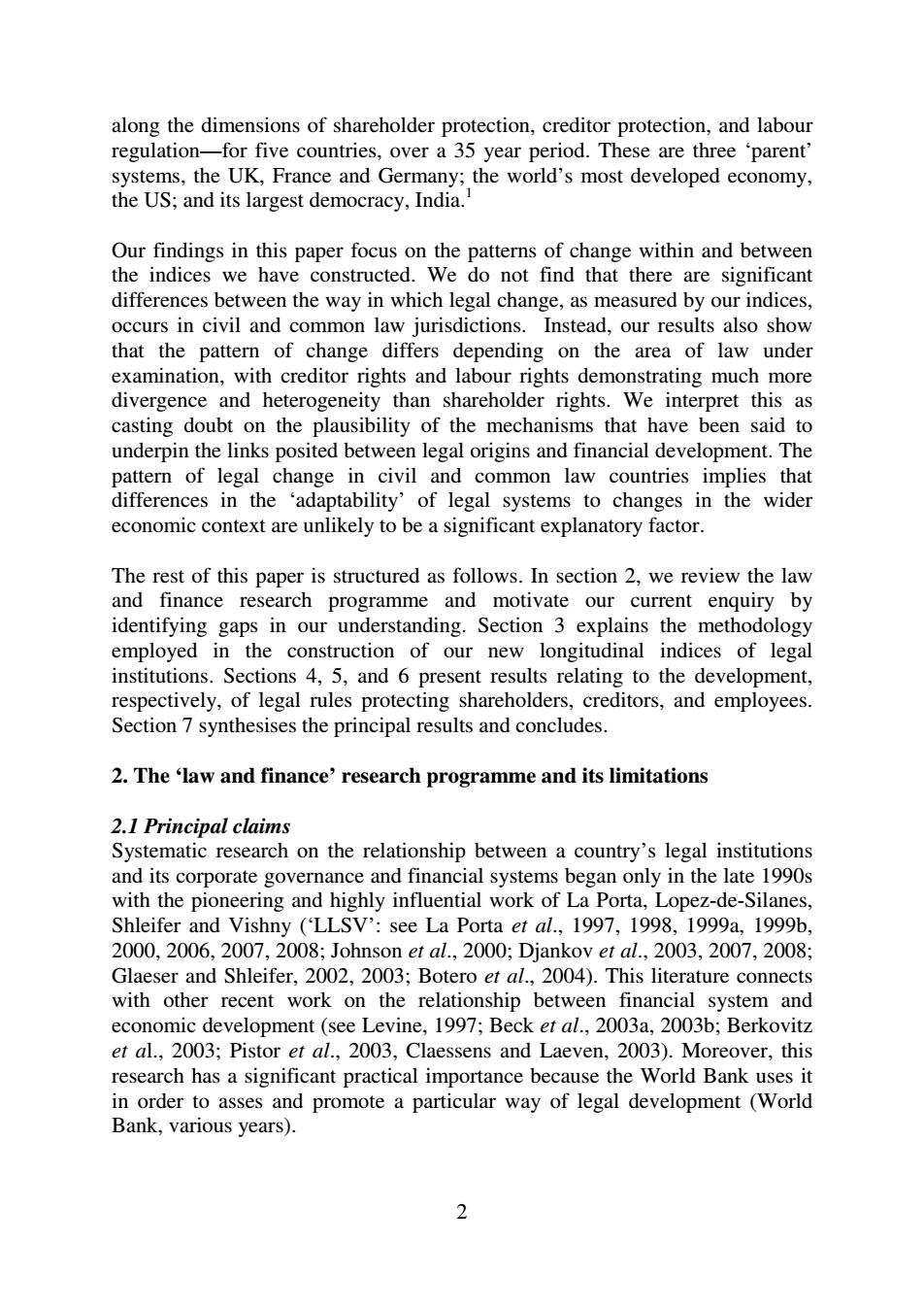正在加载图片...

along the dimensions of shareholder protection,creditor protection,and labour regulation-for five countries,over a 35 year period.These are three parent systems,the UK,France and Germany;the world's most developed economy, the US;and its largest democracy,India. Our findings in this paper focus on the patterns of change within and between the indices we have constructed.We do not find that there are significant differences between the way in which legal change,as measured by our indices, occurs in civil and common law jurisdictions.Instead,our results also show that the pattern of change differs depending on the area of law under examination,with creditor rights and labour rights demonstrating much more divergence and heterogeneity than shareholder rights.We interpret this as casting doubt on the plausibility of the mechanisms that have been said to underpin the links posited between legal origins and financial development.The pattern of legal change in civil and common law countries implies that differences in the 'adaptability'of legal systems to changes in the wider economic context are unlikely to be a significant explanatory factor. The rest of this paper is structured as follows.In section 2,we review the law and finance research programme and motivate our current enquiry by identifying gaps in our understanding.Section 3 explains the methodology employed in the construction of our new longitudinal indices of legal institutions.Sections 4,5,and 6 present results relating to the development, respectively,of legal rules protecting shareholders,creditors,and employees. Section 7 synthesises the principal results and concludes. 2.The 'law and finance'research programme and its limitations 2.1 Principal claims Systematic research on the relationship between a country's legal institutions and its corporate governance and financial systems began only in the late 1990s with the pioneering and highly influential work of La Porta,Lopez-de-Silanes, Shleifer and Vishny ('LLSV':see La Porta et al.,1997,1998,1999a,1999b, 2000,2006,2007,2008;Johnson et al.,2000;Djankov et al.,2003,2007,2008; Glaeser and Shleifer,2002,2003;Botero et al.,2004).This literature connects with other recent work on the relationship between financial system and economic development (see Levine,1997;Beck et al.,2003a,2003b;Berkovitz et al.,2003;Pistor et al.,2003,Claessens and Laeven,2003).Moreover,this research has a significant practical importance because the World Bank uses it in order to asses and promote a particular way of legal development (World Bank,various years). 22 along the dimensions of shareholder protection, creditor protection, and labour regulation—for five countries, over a 35 year period. These are three ‘parent’ systems, the UK, France and Germany; the world’s most developed economy, the US; and its largest democracy, India.1 Our findings in this paper focus on the patterns of change within and between the indices we have constructed. We do not find that there are significant differences between the way in which legal change, as measured by our indices, occurs in civil and common law jurisdictions. Instead, our results also show that the pattern of change differs depending on the area of law under examination, with creditor rights and labour rights demonstrating much more divergence and heterogeneity than shareholder rights. We interpret this as casting doubt on the plausibility of the mechanisms that have been said to underpin the links posited between legal origins and financial development. The pattern of legal change in civil and common law countries implies that differences in the ‘adaptability’ of legal systems to changes in the wider economic context are unlikely to be a significant explanatory factor. The rest of this paper is structured as follows. In section 2, we review the law and finance research programme and motivate our current enquiry by identifying gaps in our understanding. Section 3 explains the methodology employed in the construction of our new longitudinal indices of legal institutions. Sections 4, 5, and 6 present results relating to the development, respectively, of legal rules protecting shareholders, creditors, and employees. Section 7 synthesises the principal results and concludes. 2. The ‘law and finance’ research programme and its limitations 2.1 Principal claims Systematic research on the relationship between a country’s legal institutions and its corporate governance and financial systems began only in the late 1990s with the pioneering and highly influential work of La Porta, Lopez-de-Silanes, Shleifer and Vishny (‘LLSV’: see La Porta et al., 1997, 1998, 1999a, 1999b, 2000, 2006, 2007, 2008; Johnson et al., 2000; Djankov et al., 2003, 2007, 2008; Glaeser and Shleifer, 2002, 2003; Botero et al., 2004). This literature connects with other recent work on the relationship between financial system and economic development (see Levine, 1997; Beck et al., 2003a, 2003b; Berkovitz et al., 2003; Pistor et al., 2003, Claessens and Laeven, 2003). Moreover, this research has a significant practical importance because the World Bank uses it in order to asses and promote a particular way of legal development (World Bank, various years)